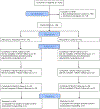Computer-delivered personalized feedback intervention for hazardous drinkers with elevated anxiety sensitivity: A pilot randomized controlled trial
- PMID: 33813352
- PMCID: PMC8119384
- DOI: 10.1016/j.brat.2021.103847
Computer-delivered personalized feedback intervention for hazardous drinkers with elevated anxiety sensitivity: A pilot randomized controlled trial
Abstract
Hazardous drinkers with emotional vulnerabilities (e.g., elevated anxiety sensitivity) remain an underserved group. This study aimed to evaluate the feasibility, acceptability, and initial efficacy of a single session remotely-delivered personalized feedback intervention (PFI) targeting alcohol (mis)use and anxiety sensitivity among college students. Hazardous drinkers with elevated anxiety sensitivity (N = 125; 76.8% female; Mage = 22.14; 66.4% racial/ethnic minorities) were randomized to receive the integrated PFI (n = 63) or attention control (n = 62). Follow-up assessments were conducted one-week, one-month and three-months post-intervention. Latent growth curve modeling was used to test pilot outcomes. It was feasible to recruit and retain hazardous drinking students with elevated anxiety sensitivity through follow-up with no group differences in retention. The integrated PFI was rated as more acceptable than the control with medium/large differences (p's < 0.004; d's = 0.54-0.80). The integrated PFI group had statistically significantly greater change in primary outcomes: motivation, hazardous alcohol use, and anxiety sensitivity (p's < 0.05; d's = 0.08-0.37) with larger within-group effect sizes (d's = 0.48-0.61) than in control (d's = 0.26-0.54). Despite a small sample size, this one-session intervention offers promise among a high-risk group of drinkers with emotional vulnerabilities. The computer-based format may allow for mass distribution of a low-cost intervention in the future; however, follow-up testing in larger samples is needed.
Keywords: Affect; Comorbidity; Integrated; Intervention; Technology; Transdiagnostic.
Copyright © 2021 Elsevier Ltd. All rights reserved.
Conflict of interest statement
Conflicts of Interest
Authors report no conflicts of interest
Figures
Similar articles
-
Evaluation of an integrated personalized feedback intervention for hazardous drinkers with elevated anxiety sensitivity and PTSD symptoms: Protocol for a randomized controlled trial.Contemp Clin Trials Commun. 2023 Feb 4;32:101088. doi: 10.1016/j.conctc.2023.101088. eCollection 2023 Apr. Contemp Clin Trials Commun. 2023. PMID: 36824449 Free PMC article.
-
Computer-delivered personalized feedback intervention for hazardous drinkers with elevated anxiety sensitivity: Study protocol for a randomized controlled trial.J Health Psychol. 2021 Oct;26(12):2349-2358. doi: 10.1177/1359105320909858. Epub 2020 Mar 4. J Health Psychol. 2021. PMID: 32126840
-
The prevalence and impact of elevated anxiety sensitivity among hazardous drinking college students.Drug Alcohol Depend. 2020 Apr 1;209:107922. doi: 10.1016/j.drugalcdep.2020.107922. Epub 2020 Feb 15. Drug Alcohol Depend. 2020. PMID: 32088590 Free PMC article.
-
The efficacy of computerized alcohol intervention tailored to drinking motives among college students: a quasi-experimental pilot study.Am J Drug Alcohol Abuse. 2015 Mar;41(2):183-7. doi: 10.3109/00952990.2014.991022. Am J Drug Alcohol Abuse. 2015. PMID: 25700006 Clinical Trial.
-
Personalized Feedback for Smoking and Anxiety Sensitivity: A Randomized Controlled Trial.Subst Use Misuse. 2021;56(7):929-940. doi: 10.1080/10826084.2021.1900255. Epub 2021 Mar 25. Subst Use Misuse. 2021. PMID: 33761839 Free PMC article. Clinical Trial.
Cited by
-
Evaluation of an integrated personalized feedback intervention for hazardous drinkers with elevated anxiety sensitivity and PTSD symptoms: Protocol for a randomized controlled trial.Contemp Clin Trials Commun. 2023 Feb 4;32:101088. doi: 10.1016/j.conctc.2023.101088. eCollection 2023 Apr. Contemp Clin Trials Commun. 2023. PMID: 36824449 Free PMC article.
-
Motivational interviewing-based interventions with patients with comorbid anxiety and substance use disorders.Curr Opin Psychol. 2024 Dec;60:101934. doi: 10.1016/j.copsyc.2024.101934. Epub 2024 Nov 1. Curr Opin Psychol. 2024. PMID: 39520817 Review.
-
Interoceptive anxiety-related processes: Importance for understanding COVID-19 and future pandemic mental health and addictive behaviors and their comorbidity.Behav Res Ther. 2022 Sep;156:104141. doi: 10.1016/j.brat.2022.104141. Epub 2022 Jun 18. Behav Res Ther. 2022. PMID: 35752013 Free PMC article. Review.
-
A sex- and gender-based analysis of alcohol treatment intervention research involving youth: A methodological systematic review.PLoS Med. 2024 Jun 3;21(6):e1004413. doi: 10.1371/journal.pmed.1004413. eCollection 2024 Jun. PLoS Med. 2024. PMID: 38829916 Free PMC article.
-
Development of a Personalized Feedback Intervention Targeting Pain-Related Anxiety for Adults Reporting Hazardous Drinking and Chronic Pain: A Randomized Controlled Trial.J Stud Alcohol Drugs. 2024 Sep;85(5):682-693. doi: 10.15288/jsad.23-00359. Epub 2024 Apr 15. J Stud Alcohol Drugs. 2024. PMID: 38619311 Clinical Trial.
References
-
- Babor TF, Higgins-Biddle JC, Saunders JB, & Monteiro MG (2001). The Alcohol Use Disorders Identification Test: Guidelines for Use in Primary Care. Geneva. World Health Organization, Department of Mental Health and Substance Dependence
Publication types
MeSH terms
Grants and funding
LinkOut - more resources
Full Text Sources
Other Literature Sources
Medical


